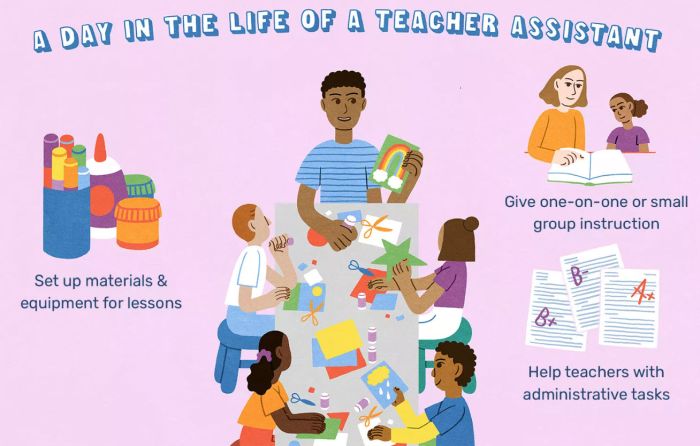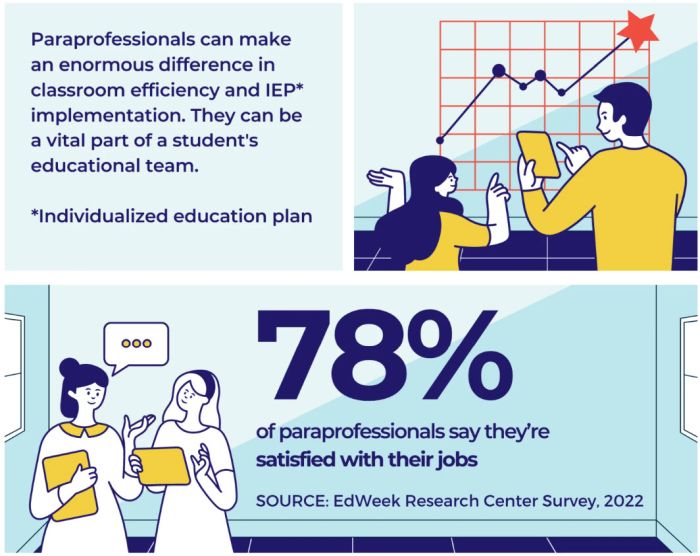Classroom communities often include more than just teachers and students. One important member of the team can be an education paraprofessional, also called a teaching assistant or classroom aide. But what does a teaching assistant do, and who is the job right for? Here are answers to some common questions, with thoughts from real teachers on the WeAreTeachers HELPLINE group on Facebook.
What is a K-12 paraprofessional teaching assistant?
A teaching assistant is someone who supports students and teachers in the classroom. The position can be full-time or part-time, and the job description varies widely based on the school, grade level, and classroom makeup. The official title is often “education paraprofessional,” frequently shortened to “para.” Some schools call them “classroom aides” or “teacher aides.”
In many ways, a teaching assistant is a lot like a nurse. Nurses help both patients and doctors but aren’t ultimately responsible for making decisions about diagnoses and patient care. In a classroom, teachers take responsibility for lesson planning and most of the teaching, while aides support students and teachers as needed.
Not all schools have classroom aides, and they’re usually more common in inclusion settings. Teaching assistants can help provide the accommodations required by individual student 504 plans or IEPs, leaving teachers free to handle the overall classroom responsibilities. Paraprofessionals are usually assigned to a specific classroom or teaching team.
Who can become a teaching assistant?
The requirements for paras and classroom aides vary depending on the state, school, and individual position. In some cases, a teaching degree may be required, though it’s more likely to simply require a college degree in general. Some positions don’t require anything more than a high school diploma and a willingness to learn.
Sometimes teaching aides are former or retired teachers who still want to work in the classroom. They can also be newly qualified graduates looking to gain some experience, or those who want to work in education while pursuing a degree on the side. Others who become paraprofessionals don’t have any education experience or background and simply want to spend their time working in a K-12 classroom.
What does a teaching assistant do?

Source: LiveAbout dotcom
Ask a classroom para what they do, and they’ll likely tell you “EVERYTHING!” And that’s true to some extent. Here are some common tasks that teaching assistants tackle:
- Admin work: Classroom aides may be asked to take attendance, make copies, laminate items, prepare and organize classroom materials, create and hang bulletin boards, grade homework and tests, and other basic tasks.
- Small groups or one-on-ones: Paras often work directly with students who need extra assistance during lessons or activities. They frequently assist with accommodation services required by IEPs or 504s, like reading aloud or offering extra time to complete assignments.
- Lunch, recess, or parking lot duty: These are no one’s favorite tasks, and sometimes teaching assistants get stuck with the bulk of them.
- Testing supervisor: When it’s standardized testing time, classroom aides can supervise students as needed. This can free up classroom teachers to spend this time on other tasks. Paras can also supervise kids who receive extra testing time or other accommodations.
- Substitute teacher: If a school finds themself in a bind, classroom aides may get pulled from their permanent positions to cover other classes in an emergency.
- Other duties as needed: Paraprofessionals may also attend staff and team meetings, escort students from one activity to another, sit with students who are anxious or ill, circulate during activities to offer assistance, and a thousand other things!
What don’t teaching assistants do?
There are some major differences between teachers and teaching assistants, and that’s often defined by what paraprofessionals don’t do. Classroom aides are not usually responsible for:
- Curriculum and lesson planning: Teachers handle their own lesson planning. They may sometimes ask assistants for their thoughts, but generally, this isn’t something teacher aides have to worry about.
- Parent communication: Though paras may be asked to sit in on conferences and IEP/504 meetings, they’re not ultimately responsible for parent communication. This is the job of the the classroom teacher/s.
- Teaching: While classroom aides may occasionally fill in or provide some basic instruction, this is almost always the purview of the teachers themselves.
- Work off the clock: While teachers are well known for taking work home during evenings and weekends, teaching assistants don’t need to worry about this! They’re usually paid hourly, and their teaching day starts and stops at assigned hours.
How much are teaching assistants paid?

Source: Education Week
This is another factor that varies based on district, experience, and location. Indeed.com reports that in 2023, full-time K-12 teaching assistants can expect to make an average about $32,000 per year, or a little over $15 per hour.
Full-time entry-level assistants can make as little as $23,000 a year, while those in high-income areas who have many years of experience could earn as much as $46,000 annually. Part-timers can earn anywhere from about $10.50 to $21.50 an hour.
Depending on the state and district, paraprofessionals may or may not be eligible for health care or retirement benefits, and may not be a part of a teacher’s union.
What are the pros and cons of being a teaching assistant?
Wondering what it’s really like to be a classroom paraprofessional? Here are the thoughts and experiences of real teaching aides.
“Loved every minute of it … until they made changes to the hours and I could no longer do it. Prepare to be a substitute anything, anytime. But punch that time clock and leave work at work!” —Tina D.
“I would be a para forever if I could afford to. It’s great.” —Hanna B.
“I know two retired educators who went back as paras. Both were happy but ended up doing more than the job required. Lol. We just can’t help it.” —Reita B.
“It’s decent, you don’t have much planning or responsibility, which is nice, but there are usually no benefits and the pay is hourly so you don’t get paid when there is a break. Just plan accordingly.” —Stacey H.
“I just finished a year as an assistant. It was nice—no lesson plans, no work to take home, no grading—but the pay is very low, it is part-time with no benefits, 2 sick days a year. I am glad to have done it, but I’m ready to move on.” —Mariah D.
“Assistant teacher is an excellent way to secure a full-time salaried position. In our district and surrounding, it’s almost a given that someone who pulls their time as an aide gets the job over someone who isn’t already working in the county.” —Miranda N.
“Teacher assistant is how I started. Had to leave where I started to get a full-time teacher position, but the experience was invaluable.” —Jennifer L.
Have more questions about becoming a paraprofessional teaching assistant or classroom aide? Come ask for advice on the WeAreTeachers HELPLINE group on Facebook.
Plus, check out A Teacher’s Guide to Working With Paraprofessionals.

